外刊经贸知识选读Lesson1 China in the market Place
- 格式:ppt
- 大小:2.96 MB
- 文档页数:70
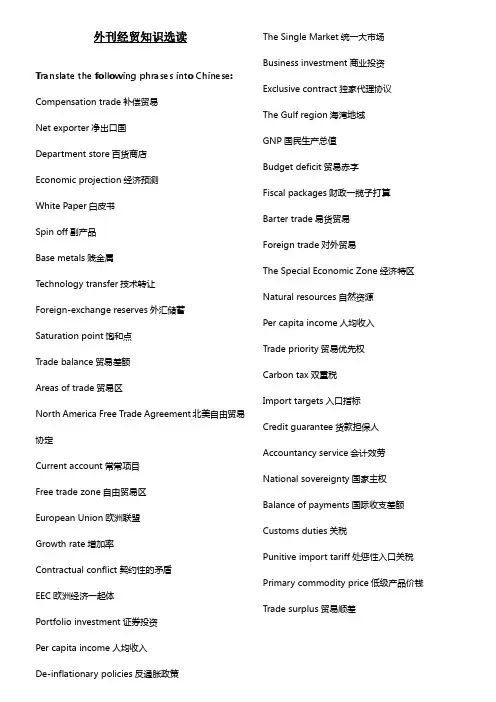
外刊经贸知识选读Translate the following phrases into Chinese: Compensation trade补偿贸易Net exporter净出口国Department store百货商店Economic projection经济预测White Paper白皮书Spin off副产品Base metals贱金属Technology transfer技术转让Foreign-exchange reserves外汇储蓄Saturation point饱和点Trade balance贸易差额Areas of trade贸易区North America Free Trade Agreement北美自由贸易协定Current account常常项目Free trade zone自由贸易区European Union欧洲联盟Growth rate增加率Contractual conflict契约性的矛盾EEC欧洲经济一起体Portfolio investment证券投资Per capita income人均收入De-inflationary policies反通胀政策The Single Market统一大市场Business investment商业投资Exclusive contract独家代理协议The Gulf region海湾地域GNP国民生产总值Budget deficit贸易赤字Fiscal packages财政一揽子打算Barter trade易货贸易Foreign trade对外贸易The Special Economic Zone经济特区Natural resources自然资源Per capita income人均收入Trade priority贸易优先权Carbon tax双重税Import targets入口指标Credit guarantee货款担保人Accountancy service会计效劳National sovereignty国家主权Balance of payments国际收支差额Customs duties关税Punitive import tariff处惩性入口关税Primary commodity price低级产品价钱Trade surplus贸易顺差Top priority第一优先Hard currency硬通货Technology transfer技术转让Public funds国家资金Sliding price浮动价钱Debt restructuring债务调整Net exporter净出口国Wet market生肉、鱼、禽、蛋市场The General Agreement on Tariffs and Trade关贸总协定Market forces市场力量Petrochemical complex石油化学企业Tax breaks税额优惠Import targets入口指标Trade reprisal贸易报复Trade barrier贸易壁垒Most-favored nation treatment最惠国待遇Imports of capital资本入口Gross national product国民生产总值Domestic demand国内需求Trade barrier贸易壁垒Current-account常常项目Domestic policy内政Debtor nations债务国Snack food小吃Financial instrument金融证券Foreign exchange reserves外汇储蓄Technical transformation技术改造Free market自由市场Holding company控股公司A chamber of commerce商会Bargain basement廉价部Trade fairs贸易展览会Trade volume贸易量Service industry效劳业Capital stock实际资本Capital equipment资本设备High-tech economy高科技经济Semiconductor chips半导体集成电路芯片Electronic commerce电子商务Process a loan办理贷款手续Retail sale零售Make way for为——让路Liquid assets流动资产Developing countries进展中国家Precious metals贵金属Discount rate贴现率Securities有价证券Spot market现货市场Transfers component资本转移部份Trade barrier贸易壁垒Net assets净资产Barrier-free market无壁垒市场Trade reprisal贸易报复Trade inventories贸易库存Nominal dollar terms名义美元价Unfair trade不平等交易Exclusive contract独家经销合同Per capita income人均收入Long-term strategy长期战略GATT关税及贸易总协定Financial crisis金融危机Trade representative商务代表Physical market现货市场Financial deregulation撤销金融管制规定Sovereignty dispute主权争端Most-favored nation treatment最惠国待遇Trade surplus贸易顺差Hard currency硬通货Merger of banks银行兼并Liquid assets易于变卖的资产/流动资金A hermit nation闭关自守的国家Trade negotiation贸易谈判At a rough estimate据粗略估量Chinese Export Commodities Fair中国出口商品交易会Foreign exchange reserves外汇储蓄Most-favored nation treatment最惠国待遇Trade surplus贸易顺差Hard currency硬通货Merger of banks银行兼并Liquid assets易于变卖的资产A hermit nation闭关自守的国家Trade negotiation贸易谈判At a rough estimate据粗略估量Chinese Export Commodities Fair中国出口商品交易会Foreign exchange reserves外汇储蓄Fiscal packages财政一揽子打算Countervailing duty反补助税Debt service利息付款Liquid assets易于变卖的资产Good resistance强阻力Current account常常项目Cash crops经济作物GNP国民生产总值De-inflationary policy反通货政策Equivalent value对等价值Industrialization programme工业化项目National income国民收入Volume of foreign trade对外贸易额Visible trade account有形贸易收支Invisible trade account无形贸易收支Growth rate增加率Foreign exchange外汇Trade fairs贸易展览会Production goods生产资料Customs duties关税Capital stock实际资本Infrastructure基础设施Foreign-exchange reserves外汇储蓄Customer goods消费品Saturation point饱和点Showpiece优秀样品Industrial crops经济作物Gross national product国民生产总值Economic power经济强国Punitive import tariff处惩性入口关税Securities and real-estate markets证券及房地产市场Conglomerate跨行业公司Commercial hub商业活动中心Per capita人均Portfolio investment证券投资Nominal terms名义价Constant terms不变价Debt restructuring债务调整Trade sanctions贸易制裁General Agreement on T ariffs and Trade关税及贸易总协定Trade surplus贸易顺差Trade agreement贸易协定Government procurement政府采购North America Free Trade Agreement北美自由贸易协定European Community欧洲一起体European Union欧洲联盟The Single Market统一大市场Free-trade zone自由贸易区Plant modernization工厂现代化European integration欧洲一体化Obtain access to a market取得进入一个市场的机遇Trade reprisal贸易报复Trade representative 贸易代表Import targets入口指标Fiscal packages财政一揽子打算Multilateral rules多边规那么Quantifiable results定量结果Conglomerate联合大企业Joint venture合伙企业Leviathan zaibatsu大财团Interest rates利率The lion’s share最大的份额Antidumping反倾销Loss leader赔本出售的商品Carbon tax双重税OPEC石油输出国组织The Gulf region海湾地域CECF中国出口商品交易会GATT关税及贸易总协定Market forces市场力量Countervailing duty反补助税Intellectual property right知识产权Trade in service效劳贸易Common Agriculture Policy一起农业政策Barter易货贸易Convertible currency可兑换货币Debt service归还贷款Countertrade对等贸易Counter purchase反向购买Debtor nations债务国Creditor nations债权国Reformulation从头配方Security有价证券Franchise特许经销权wholesaler批发商retailer零售商promote sales促销商品USDA美国农业部Luck draw幸运抽奖Spin-offs副产品,副作用Liquid assets流动资金Surplus produce生产多余Financial futures期货Currency movements货币流通Inflation通货膨胀Firm坚挺Buoyant活跃Steady坚稳Quiet清淡Stagnant停滞Heavy很呆滞Easy疲软Irregular涨落不定Erratic反复无常Irregular lower曲折下降Uncertain捉摸不定Translate the following phrases into English:贱金属base metals贵金属precious metals呆滞dull贴现率discount rate现货市场spot market欧共体European Economic Community期货市场futures market伦敦五金交易所London Metal Exchange超级市场supermarket增加出口打算Export Enhancement Program快餐店fast food shops贸易结构structure of trade咸鸭蛋preserved duck eggs茶鸡蛋eggs cooked in salt and tea leaves价钱指数price index软商品soft commodities削价战price-cutting war投资基金investment funds出口配额制度export quota system国际金融机构the international financial institution 货币贮存currency reserves国际货币基金the International Monetary Fund货币互换currency exchange 多边贸易multilateral trade清算协定Clearing Agreements补偿协定Compensation Agreements优惠券coupons独家经销合同exclusive contract试销市场test market独家代理协议exclusive contract基础设施infrastructure征收入口附加税impose import surcharge 商会chamber of commerce再出口reexports产地证明书certificate of origin据保守估量on a conservative estimate形成一种要挟pose a threat经济增大economic growth乌拉圭回合谈判the Uruguay round talk世界贸易组织the World Trade Organization 农业爱惜farm protection治理贸易managed trade贸易差额trade balance白皮书white paper双边顺差bilateral surplus年增加率annual growth rate投资资本investment capital税额优惠tax breaks金融体制financial system禁运embargo经济自由化economic liberalization贸易优先权trade priority贸易歧视trade discriminations贸易妥协trade concession经济一体化economic integration政治一体化political integration无壁垒市场barrier-free market经济利益economic benefits贸易顺差trade surplus资本转移部份transfers component预算赤字budget deficit利率interest rate低级产品价钱primary commodity price七国集团the Group of Seven工人侨汇worker’s remittance优先权preferred status关税及贸易总协定General Agreement on T ariffs and Trade国内生产总值Gross Domestic Product竞争优势competitive advantage贸易集团trade bloc新兴企业newly-rising enterprises集装箱工厂container plant 国际财团Consortium反弹bounce back自由市场free market补偿贸易compensation trade合伙企业joint venture常常项目current account打算经济planned economy出口定额export quota增加点growth point高科技产业high-tech industries经济特区the Special Economic Zone所得税税率income tax rate技术改造technical transformation技术转让technology transfer资本设备capital equipment优惠税率preferential tax rate资本密集型投资capital-intensive investment 合作企业cooperative enterprise资本入口imports of capital效劳业service industry外汇管制foreign exchange control反向贸易counter trade省会provincial capital竞争优势competitive advantage经济局面economic dimensions内部融资internal financing中波medium wave期货financial futures燃气轮机gas turbine资本货物capital goods资本密集型投资capital-intensive investment 政府采购government procurement优惠税率preferential tax rate贸易歧视trade discriminations贸易妥协trade concession贸易制裁trade sancitions核定资本authoried capital市场魅力market appeal广告词marketing messages利率interest rate竞争优势competitive advantage货币政策monetary policy曲折下降irregularly lower补偿贸易compensation trade出口定额export quota外汇管制foreign exchange control经济结构economic structure低级产品primary commodity工人侨汇workers’ remittance贸易体制trade framework 国家资金public funds国民收入national income入口限额import quota贸易公司trading companies硬通货hard currency固执己见stick by one’s guns自由贸易区free-trade zone产地证明书certificate of origin贸易差额trade balance合伙企业joint venture贸易集团trading block无形贸易收支invisible account所得税税率income tax rate证券及房地产市场securities and real estate markets 预算赤字budget deficit净资产net assets家用电器consumer electronics贸易逆差trade deficit入口指标import targets财政一揽子打算fiscal packages资本密集型投资capital-intensive investment知识产权intellectual property right效劳贸易trade in services经济封锁economic blockade贸易限制trade restrictions国内需求domestic demand优先权preferred status反倾销antidumping出口经济export economy最大份额the lion’s share有形贸易visible trade有形贸易收支visible trade account 消费品consumer goods经济强国economic power商品市场commodity market初步协定preliminary agreements 坏账bad debts冒充产品pirate good债权国creditor nations自动售货机vending machine贫困地域distressed region外汇业务foreign exchange business 税率tax rate私营企业private business首席执行官Chief Executive Officer 赔本出售的商品loss leader容易被骗被骗的人fall guy贸易协定trade agreement贸易顺差trade surplus生产方式means of production 优惠税率preferential tax rate利润汇款profit-remittance出口经济export economy高科技公司high technology firm电路板circuit board销售总额gross sales把握——的线索keep track of强行推销hard sell国际货币基金组织the International Monetary Fund 工业原料industrial material高增加率high growth rate处惩性入口关税punitive import tariff收入指数income index每一年per annum赤字in deficit顺差in surplus海关税customs duties国民收入national income有形贸易收支visible trade account反补助税countervailing duty无形贸易收支invisible account利息付款debt service / interest payment外商独资sole foreign-funded技术转让technology transfer国内需求domestic demand出口导向export-oriented贸易差额trade balance产地证书certificate of origin期货市场futures market市场份额market share入口税import duties独家经销合同exclusive contract常常项目current account清算协议clearing agreement人均收入per capita income无壁垒市场barrier-free market双重税carbon tax房地产real estate试销test market知识产权intellectual property right商业周期business cycle国民收入national income国际收支balance of payments收盘价closing level处惩性入口关税punitive import tariff证券投资portfolio investment商品市场commodity market自由市场(无壁垒市场)barrier-free market 智囊团/顾问班子brain trust产地证明书certificate of origin 对等价值equivalent value市场份额market share供给欠缺short supply世界银行the World Bank资本货物capital goods生产力productive forces国内需求domestic demand外汇收入foreign exchange earnings 入口税customs duties有形贸易收支visible trade account 利润汇款profit-remittanceIn return for: 作为对~的互换Permit: 许诺Run-down: 减少,减缩Accelerate: 加速,增速Reinforce: 增强,增强By means of: 通过,借助于Concessionary: 优惠的,减让的Substantial: 可观的,大量的,相当数量的Exacerbated: 加重Deepened: 加深Stagnated: 停滞Deteriorated: 加重、恶化SEZ: the Special Economic Zone经济特区Equipped with: 用~装备,具有Cope with: (成功)应付,(妥帖)处置Preferential: 优惠的It will be some time before~: ~还需要一段时刻Many economists believe a standard estimate of China’s per capita gross national product is already two to three times too low.许多经济学家以为,对中国人均国民生产总值的标准估量太低了,实际应该是这数字的2到3倍。
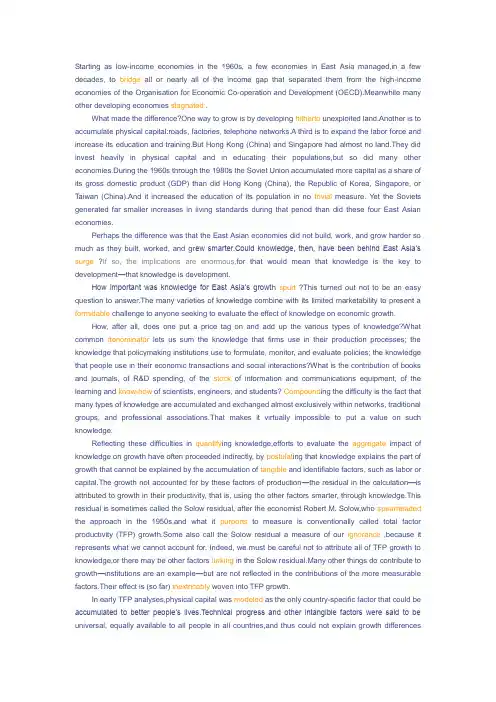
Starting as low-income economies in the 1960s, a few economies in East Asia managed,in a few decades, to bridge all or nearly all of the income gap that separated them from the high-income economies of the Organisation for Economic Co-operation and Development (OECD).Meanwhile many other developing economies stagnated .What made the difference?One way to grow is by developing hitherto unexploited land.Another is to accumulate physical capital:roads, factories, telephone networks.A third is to expand the labor force and increase its education and training.But Hong Kong (China) and Singapore had almost no land.They did invest heavily in physical capital and in educating their populations,but so did many other economies.During the 1960s through the 1980s the Soviet Union accumulated more capital as a share of its gross domestic product (GDP) than did Hong Kong (China), the Republic of Korea, Singapore, or Taiwan (China).And it increased the education of its population in no trivial measure. Yet the Soviets generated far smaller increases in living standards during that period than did these four East Asian economies.Perhaps the difference was that the East Asian economies did not build, work, and grow harder so much as they built, worked, and gr ew smarter.Could knowledge, then, have been behind East Asia’s surge ?If so, the implications are enormous,for that would mean that knowledge is the key to development—that knowledge is development.How important was knowledge for East Asia’s growt h spurt ?This turned out not to be an easy question to answer.The many varieties of knowledge combine with its limited marketability to present a formidable challenge to anyone seeking to evaluate the effect of knowledge on economic growth.How, after all, does one put a price tag on and add up the various types of knowledge?What common denominator lets us sum the knowledge that firms use in their production processes; the knowledge that policymaking institutions use to formulate, monitor, and evaluate policies; the knowledge that people use in their economic transactions and social interactions?What is the contribution of books and journals, of R&D spending, of the stock of information and communications equipment, of the learning and know-how of scientists, engineers, and students? Compound ing the difficulty is the fact that many types of knowledge are accumulated and exchanged almost exclusively within networks, traditional groups, and professional associations.That makes it virtually impossible to put a value on such knowledge.Reflecting these difficulties in quantify ing knowledge,efforts to evaluate the aggregate impact of knowledge on growth have often proceeded indirectly, by postulat ing that knowledge explains the part of growth that cannot be explained by the accumulation of tangible and identifiable factors, such as labor or capital.The growth not accounted for by these factors of production—the residual in the calculation—is attributed to growth in their productivity, that is, using the other factors smarter, through knowledge.This residual is sometimes called the Solow residual, after the economist Robert M. Solow,who spearheaded the approach in the 1950s,and what it purports to measure is conventionally called total factor productivity (TFP) growth.Some also call the Solow residual a measure of our ignorance ,because it represents what we cannot account for. Indeed, we must be careful not to attribute all of TFP growth to knowledge,or there may be other factors lurking in the Solow residual.Many other things do contribute to growth—institutions are an example—but are not reflected in the contributions of the more measurable factors.Their effect is (so far) inextricably woven into TFP growth.In early TFP analyses,physical capital was modeled as the only country-specific factor that could be accumulated to better people’s lives.Technical progress and other intangible factors were said to be universal, equally available to all people in all countries,and thus could not explain growth differencesbetween countries.Their contributions to growth were lumped with the TFP growth numbers.Although this assumption was convenient, it quickly became obvious that physical capital was not the only factor whose accumulation drove economic growth. A study that analyzed variations in growth rates across a large number of countries showed that the accumulation of physical capital explained less than 30 percent of those variations.The rest—70 percent or more—was attributed directly or indirectly to the intangible factors that make up TFP growth (Table 1.1).Later attempts introduced human capital to better explain the causes of economic growth.A higher level of education in the population means that more people can learn to use better technology. Education was surely a key ingredient in the success of four of the fastest-growing East Asian economies: Hong Kong (China), the Republic of Korea, Singapore, and Taiwan (China). Before their transformation from developing into industrializing economies, their school enrollment rates had been much higher than those of other developing countries (Table 1.2).They had also emphasized advanced scientific and technical studies—as measured by their higher ratios of students in technical fields than in even some industrial countries—thus enhancing their capacity to import sophisticated technologies.Moreover, the importance of education for economic growth had long been recognized and established empirically .One study had found that growth in years of schooling explained about 25 percent of the increase in GDP per capita in the United States between 1929 and 1982.Adding education reduced the part of growth that could not be explained,thus shrinking the haystack in which TFP growth (and knowledge) remained hidden.Some analysts even concluded, perhaps too quickly,that physical and human capital, properly accounted for, explained all or virtually all of the East Asian economies’ rapid growth,leaving knowledge as a separate factor out of the picture.One re ason these analysts came up with low values for TFP growth is that they incorporated improvements in labor and equipment into their measurement of factor accumulation.So even their evidence of low TFP growth in East Asia does not refute the importance of closing knowledge gaps.Indeed, it shows that the fast-growing East Asian economies had a successful strategy to close knowledge gaps:by investing in the knowledge embodi ed in physical capital, and by investing in people and institutions to enhance the capability to absorb and use knowledge.Looking beyond East Asia,other growth accounting studies have examined larger samples of countries.Even when human capital is accounted for,the unexplained part of growth remains high.One such study, of 98 countries with an unweighted average growth rate of output per worker of 2.24 percent,found that 34 percent (0.76 percentage point) of that growth came from physical capital accumulation,20 percent (0.45 percentage point) from human capital accumulation,and as much as 46 percent (just over 1 percentage point) from TFP growth.Even more remains to be explained in variations in growth rates across countries. The same study found the combined role of human and physical capital to be as low as 9 percent, leaving the TFP residual at a staggering 91 percent.To take another example:Korea and Ghana had similarly low incomes per capita in the 1950s,but by 1991 Korea’s income per capita was more than seven times Ghana’s.Much of that gap remains unexplained even when human capital is taken into account .All these results are subject to measurement problems.For example, the measured stock of human capital may overstate the actual quantity used in producing goods and services.High rates of school enrollment or attainment (years completed) may not translate into higher rates of economic growthif the quality of education is poor, or if educated people are not employed at their potential because of distortion s in the labor market.Moreover, it is now evident that education without openness to innovation and knowledge will notlead to economic development.The people of the former Soviet Union, like the people of the OECD countries and East Asia, were highly educated, with nearly 100 percent literacy .And for an educated population it is possible,through foreign direct investment and other means,to acquire and use information about the latest production and management innovations in other countries.But the Soviet Union placed severe restrictions on foreign investment, foreign collaboration, and innovation.Its work force did not adapt and change as new information became available elsewhere in the world, and consequently its economy suffered a decline.(excerpted from World Development Report 1998/1999)一些东亚国家在20世纪60年代还是低收入国家,但是在短短的几十年之间,他们成功地弥补了其与经济合作与发展组织(OECD)中高收入国家之间的差距;与此同时,也有许多发展中国家的经济停滞不前。
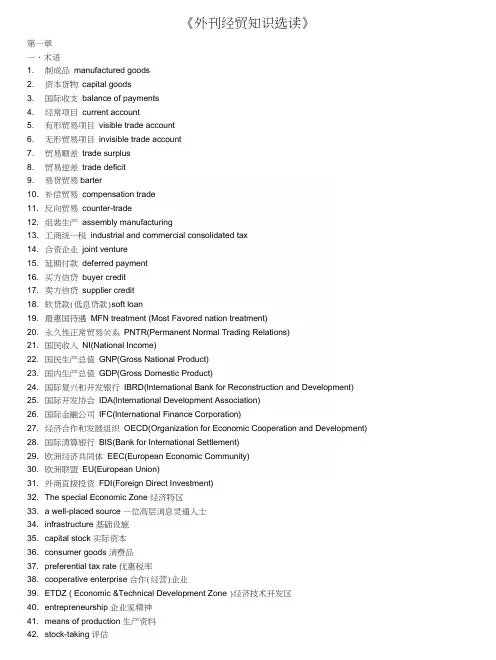
《外刊经贸知识选读》第一章—、术语1. 制成品manufactured goods2. 资本货物capital goods3. 国际收支balance of payments4. 经常项目current account5. 有形贸易项目visible trade account6. 无形贸易项目invisible trade account7. 贸易顺差trade surplus8. 贸易逆差trade deficit9. 易货贸易barter10. 补偿贸易compensation trade11. 反向贸易counter-trade12. 组装生产assembly manufacturing13. 工商统一税industrial and commercial consolidated tax14. 合资企业joint venture15. 延期付款deferred payment16. 买方信贷buyer credit17. 卖方信贷supplier credit18. 软贷款(低息贷款)soft loan19. 最惠国待遇MFN treatment (Most Favored nation treatment)20. 永久性正常贸易关系PNTR(Permanent Normal Trading Relations)21. 国民收入NI(National Income)22. 国民生产总值GNP(Gross National Product)23. 国内生产总值GDP(Gross Domestic Product)24. 国际复兴和开发银行IBRD(lnternational Bank for Reconstruction and Development)25. 国际开发协会IDA(lnternational Development Association)26. 国际金融公司IFC(lnternational Finance Corporation)27. 经济合作和发展组织OECD(Organization for Economic Cooperation and Development)28. 国际清算银行BIS(Bank for International Settlement)29. 欧洲经济共同体EEC(European Economic Community)30. 欧洲联盟EU(European Union)31. 外商直接投资FDI(Foreign Direct Investment)32. The special Economic Zone 经济特区33. a well-placed source —位高层消息灵通人士34. infrastructure 基础设施35. capital stock 实际资本36. consumer goods 消费品37. preferential tax rate 优惠税率38. cooperative enterprise 合作(经营)企业39. ETDZ ( Economic &Technical Development Zone )经济技术开发区40. entrepreneurship 企业家精神41. means of production 生产资料42. stock-taking 评估43. Allocation of resources 资源配置44. macro regulation and control 宏观调控45. fiscal policies 财政政策46・15.tight monetary policy紧缩的货币政策47. 16.working capital 运营资本48. 17.basic policy 基本国策49. 18.technical transformation 技术革新50.二、词语释义:substantially: dramatically, significantly, considerably 显著地,相当大地subsequently : afterwards 随后,后来exacerbate : deteriorate, worsen; aggravate ; make worse 恶化withdraw: cancellation 撤回,撤销theme : principle 主题,原则in return for: in exchange fordisrupt: interrupt 中断,打断destined : designed]注定的,H的是,有计划的pronounced: marked 宣布,宣称in the wake of: following; after with 在 ........ 之后undue : too much; unbearable 过度的,过分的reverse : change to the opposite 反转,颠倒,反向,相反buoyant: brisk 活跃的outcome: result 结果boost : stimulate; promote; develop 促进,提高,朿ij激recover: rebound 恢复facilitate : make easy促进;使容易;帮助;使便利run-down: reduction 减少,降低mount exhibitions: hold exhibitions 举办展览insofar as: to the extent 在...... 范围内bottlenecks: obstacles 障碍三、句子翻译1. During the 1950s China exported agricultural products to the USSR and East European countries in return for manufactured goods and the capital equipment required for the country…s industrialization programme which plac ed emphasis on the development of heavy industry.20世纪50年代,中国向前苏联和东欧各国出口农产品以换取制成品和国家的工业化计划所要求的资本设备,而国家的工业化计划则强调重工业的发展。
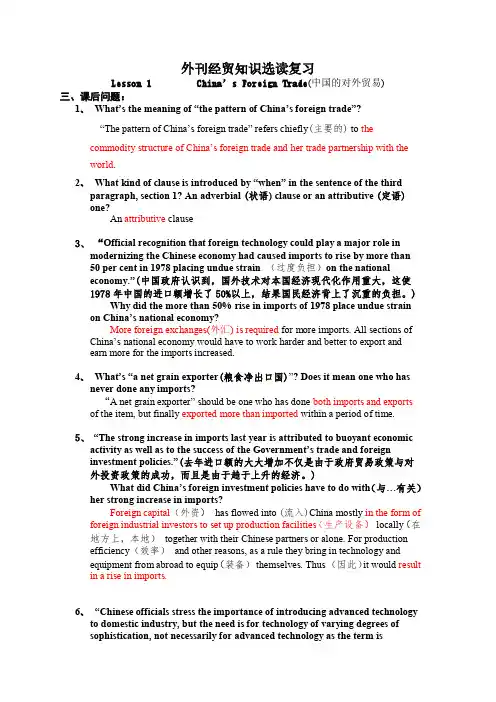
外刊经贸知识选读复习Lesson 1 China’s Foreign Trade(中国的对外贸易)三、课后问题:1、What‘s the meaning of ―the pattern of China‘s foreign trade‖?―The pattern of China‘s foreign trade‖ refers chiefly(主要的) to thecommodity structure of China‘s foreign trade and her trade partnership with theworld.2、What kind of clause is introduced by ―when‖ in the sentence of the thirdparagraph, section 1? An adverbial (状语) clause or an attributive (定语)one?An attributive clause3、“Official recognition that foreign technology could play a major role inmodernizing the Chinese economy had caused imports to rise by more than50 per cent in 1978 placing undue strain (过度负担)on the nationaleconomy.‖(中国政府认识到,国外技术对本国经济现代化作用重大,这使1978年中国的进口额增长了50%以上,结果国民经济背上了沉重的负担。
) Why did the more than 50% rise in imports of 1978 place undue strain on China‘s national economy?More foreign exchanges(外汇) is required for more imports. All sections of China‘s national economy would have to work harder and better to export andearn more for the imports increased.4、What‘s ―a net grain exporter(粮食净出口国)‖? Does it mean one who hasnever done any imports?“A net grain exporter‖ should be one who has done both imports and exportsof the item, but finally exported more than imported within a period of time.5、―The strong increase in imports last year is attributed to buoyant economicactivity as well as to the success of the Government‘s trade and foreigninvestment policies.‖(去年进口额的大大增加不仅是由于政府贸易政策与对外投资政策的成功,而且是由于趋于上升的经济。
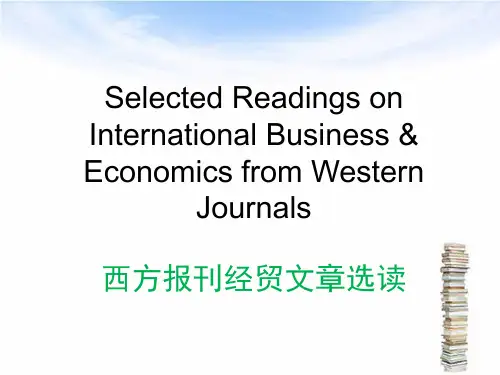
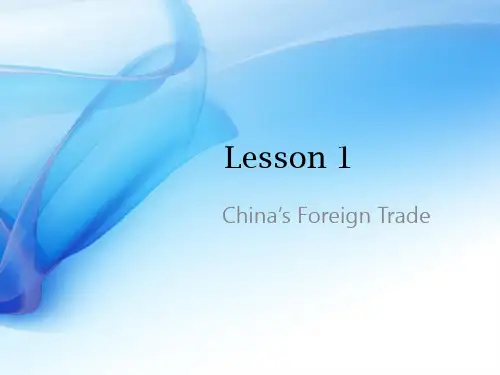

自考《外刊经贸知识选读》复习资料Lesson One China in the Market Place一、术语:manufactured goods 制成品capital equipment 资本货物balance of payments 国际收支current account 经常项目!visible trade account 有形贸易项目invisible trade account 无形贸易项目trade surplus 贸易顺差trade deficit 贸易逆差barter 易货贸易compensation trade 补偿贸易counter-trade 反向贸易《assembly manufacturing 组装生产industrial and commercial consolidated tax 工商统一税joint venture 合资企业deferred payment 延期付款buyer credit 买方信贷supplier credit 卖方信贷soft loan 软贷款(低息贷款))MFN treatment: Most Favored Nation treatment 最惠国待遇PNTR: Permanent Normal Trading Relations 永久性正常贸易关系NI: National Income 国民收入GNP: Gross National Product 国民生产总值GDP: Gross Domestic Product 国内生产总值IBRD: International Bank for Reconstruction and Development 国际复兴和开发银行IDA: International Development Association 国际开发协会:IFC: International Finance Corporation 国际金融公司OECD: Organization for Economic Cooperation and Development 经济合作和发展组织BIS: Bank for International Settlement 国际清算银行EEC: European Economic Community 欧洲经济共同体EU: European Union 欧洲联盟FDI: Foreign Direct Investment 外商直接投资二、词语释义:¥exacerbate: deteriorate 恶化disrupt: interrupt 中断in the wake of: following 继┉之后breakdown: analysis by classification 分类分析buoyant: brisk 上扬的,增产的run-down: reductionmount exhibitions: hold exhibitions、insofar as: to the extent 在┉范围之内bottlenecks: obstacles; problems that retard or halt free movement or progress三、句子翻译:Official recognition that foreign technology could play a major role in modernizing the Chinese economy has caused imports to rise by more than 50 per cent in 1978, placing undue strain on the national economy.官方认为,外国技术可在中国经济现代化中起重要作用,这导致了1978年中国的进口增加了50%以上,从而给国民经济带来了重压。
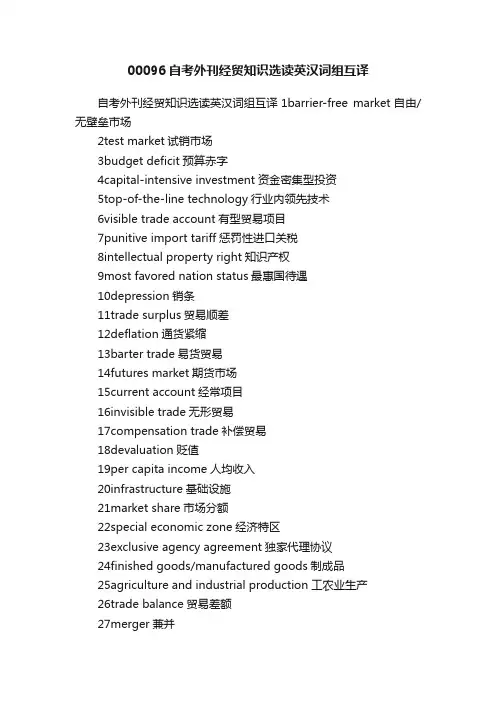
00096自考外刊经贸知识选读英汉词组互译自考外刊经贸知识选读英汉词组互译1barrier-free market自由/无壁垒市场2test market试销市场3budget deficit预算赤字4capital-intensive investment资金密集型投资5top-of-the-line technology行业内领先技术6visible trade account有型贸易项目7punitive import tariff惩罚性进口关税8intellectual property right知识产权9most favored nation status最惠国待遇10depression销条11trade surplus贸易顺差12deflation通货紧缩13barter trade易货贸易14futures market期货市场15current account经常项目16invisible trade无形贸易17compensation trade补偿贸易18devaluation贬值19per capita income人均收入20infrastructure基础设施21market share市场分额22special economic zone经济特区23exclusive agency agreement独家代理协议24finished goods/manufactured goods制成品25agriculture and industrial production工农业生产26trade balance贸易差额27merger兼并28market force市场力量29monetary policy货币政策30world trade organization世界贸易组织31personal/individual income tax个人所得税32commodity/goods market商品市场33service trade服务贸易34primary goods初级产品35international monetary fund国际货币基金组织36per capita GDP(gross domestic product)人均国内生产总值37convertible currency可兑换货币38customs duties and taxation海关关税39good infrastructure 良好的基础设施40deinflationary policy反通货膨胀政策41trade sanction贸易制裁42at the summit meeting峰会43on a conservative estimate据保守估计44price hike价格上涨45self-sufficient自给自足46liquid assets流动资产47trade fairs and exhibitions贸易展销会48preferential tax rate优惠关税49vested interests既得利益50export quota出口配额51government procurement政府采购52European integration欧洲一体化53bilateral pacts双边条约54countervailing duty反补贴税5524.fledgling industries新兴工业56stock market股票市场57capital transfer资本转移58trade discrimination贸易歧视59bilateral trade双边贸易60European continent欧洲大陆61carbon tax双重税62state-owned enterprises国有企业63competitive advantage竞争优势64balance of payments国际收支65high-tech高技术66portfolio investment证券投资67free market自由市场68trade barriers贸易壁垒69glut of supply供应过剩70equivalent value对等价值71economic recession经济衰退72unfair trade不平等交易73exclusive contract独家经销合同74per capita income人均收入75long-term strategy长期战略76GATT关税及贸易总协定77financial crisis金融危机78trade representative商务代表79physical market现货市场80financial deregulation撤销金融管制规定81sovereignty dispute主权争端82hard currency硬通货83merger of banks银行兼并84a hermit naiton闭关自守的国家85trade negotiation贸易谈判86at a rough estimate据粗略估计87Chinese export commodities fair中国出口商品交易会88foreign exchange reserve外汇储备89debt sevice/interest payment利息付款90sole foreign funded外商独资91technology transfer技术转让92domestic demand国内需求93export oriented出口导向94trade balance贸易差额95certificate of origin产地证书96customs duties进口税97clearing agreement清算协议98real estate房地产99business cycle商业周期100fiscal packages财政一揽子计划101debt service利息付款102 good resistance强阻力103cash crops经济作物104GNP国民生产总值105deinflationary policy反通胀政策106short supply供应短缺107the World Bank世界银行108capital goods资本货物109productive force生产力110foreign exchange earnings外汇收入111profit-remittance 利润汇款112national income国民收入113closing level收盘价。
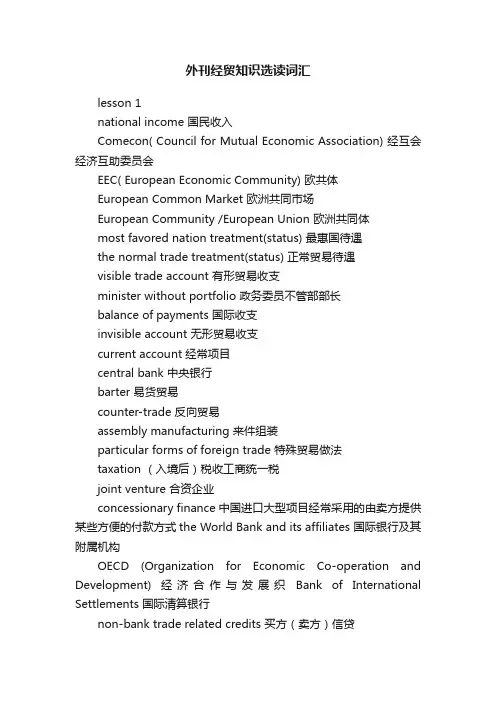
外刊经贸知识选读词汇lesson 1national income 国民收入Comecon( Council for Mutual Economic Association) 经互会经济互助委员会EEC( European Economic Community) 欧共体European Common Market 欧洲共同市场European Community /European Union 欧洲共同体most favored nation treatment(status) 最惠国待遇the normal trade treatment(status) 正常贸易待遇visible trade account 有形贸易收支minister without portfolio 政务委员不管部部长balance of payments 国际收支invisible account 无形贸易收支current account 经常项目central bank 中央银行barter 易货贸易counter-trade 反向贸易assembly manufacturing 来件组装particular forms of foreign trade 特殊贸易做法taxation (入境后)税收工商统一税joint venture 合资企业concessionary finance 中国进口大型项目经常采用的由卖方提供某些方便的付款方式the World Bank and its affiliates 国际银行及其附属机构OECD (Organization for Economic Co-operation and Development) 经济合作与发展织Bank of International Settlements 国际清算银行non-bank trade related credits 买方(卖方)信贷in the wake of 紧紧跟随在后per annum 每年in deficit 赤字逆差in surplus 赢余顺差customs duties 关税raise(money ,funds) 筹集(款项资金)lesson 2bamboo curtain /iron curtain country 竹幕铁幕国家The Special Economic Zone (SEZ) 经济特区14 coastal cities(all former treaty ports) 沿海开放城市capital stock /capital stock ,real 实际资本cooperative enterprise 合作(经营)企业State Council 国务院state councilor 国务委员pipe dream 白日梦幻想cope with 成功应付妥善处理inner regions 内地foreign-exchange reserves 外汇储备technology transfer 技术转让(to start)form scratch 从零开始wholly foreign-owned 外商独资拥有capital goods 资本货物consumer goods 消费品profit-remittance 利润汇款preferential tax rate 优惠税率be liable to 有义务应付税的entitle to 给...权利/资格strengths and weaknesses 优缺点stir up 激起has yet to 有待in the driver's seat 处于统治(或控制)地位means of production 生产资料stock-taking 盘货评估National People's Congress 全国人民代表大会lesson 3Per capita 按人均计算平均Gross National Product(GNP) 国民生产总值punitive import tariff 惩罚性进口关税securities and real estate market 政权及房地产市场"Greater China trade bloc/Chinese Economic Area 大中华贸易集团华人经济区high-tech ,high-wage economy 高技术高工资经济General Agreement on Tariffs and Trade 关税及贸易总协定WTO/World Trade Organization 世界贸易组织conglomerate 跨行业公司semiconductor chips 半导体集成电路芯片consortium 国际财团CITIC(China International Trust and Investment Company) 中国国际信托投资公司China Resources Inc 香港华润有限公司economic heavyweight 举足轻重的经济强国dump truck 翻斗车tractor-trailer 牵引拖车container plant 集装箱工厂commercial hub 商业活动中心warning shot 鸣枪示警intensifying rivalry 不断增强的竞争对抗conveyor belt 输送带preferred status 优先权have a stake in 与有利害关系appendix lesson1-lesson3productive forces 生产力cash corps 经济作物multi-party election 多党竞选a balance of the three powers 三权分立the western two-chamber system 西方两院(议会)制House of Lords/House of Commons 上议院/下议院the Senate/House of Representatives 参议院/众议院anarchy 无政府状态Presidium 共产党国家政府常务委员会standard of living 生活水平give priority to 最优先考虑surplus labour 剩余劳动力political persuasion 政治派别the sate apparatus 国家机器keep abreast of 与齐头并进bureaucratism 官僚主义官僚体系democratization 民主化lesson 4GDP(Gross Domestic Product) 国内生产总值Central and Eastern Europe 地处中东欧的前社会主义国家Gulf Crisis 海湾危机the G-7/the Group of Seven 七国集团Continental Europe 欧洲大陆deinflationary policies 反通胀政策cyclical deceleration in investment spending 周期性的投资下降hard currency 硬通货Paris Club 巴黎俱乐部Commodity Market 商品市场nominal(dollar)terms 名义(美圆)价constant(dollar)terms 不变(美圆)价格unification 东西德统一anti-inflationary monetary policy 反通货膨胀货币政策GDP(GNP) deflator 消除国内(民)生产总值通货膨胀因素指数structural problems 由于社会体制或管理制度不完善引起的问题highly leveraged corporate transactions 公司用大量借来的钱进行交易current account 经常项目transfers (component) 资本转移(部分)war-related payments 战争费用的支付European Monetary System(EMS) 欧洲货币体系the Exchange Rate Mechanism 汇率管理机制real output 以不变价格计算的产品价值the spike in oil prices 石油价格猛跌the population-weighted growth rate(of developing countries' GDP) 人口加权增长率debt restructuring 债务调整direct investment 证券投资the Gulf Countries 海湾国家in a row 连续per capita income 人均收入high rates of growth 高增长率domestic demand 国内需求debt rescheduling 重新安排债务的偿还计划rental housing 出租房屋tax-cut-induced boom 由减税引发的繁荣pick-up 好转portfolio investment 证券投资catch-up 竞争couple with 并提把联系起来worker's remittance 工人侨汇bottoming-out 经济衰退局面等降至最低点后即将复苏lesson 5US policy on Trade 美国贸易政策be prepared to do something 有准备的the US trade representative 美国贸易谈判代表result-oriented/export-oriented/growth-oriented/market-oriented 以结果为导向的NAFTA(North America Free Trade Agreements) 北美自由贸易协定(government)procurement 政府采购news service 通讯社drawn-out 冗长乏味的full-fledged 充分展开的全面贸易战misgiving(s) 疑虑to ease frictions 缓和争执减少摩擦tough negotiator 不妥协的谈判者sanction(s) 国际制裁impose against 对实行制裁trade sanctions 贸易制裁(trade)hawks 在贸易中主张实行制裁的人lesson 6the Single Market 统一市场Maastricht Treaty 马斯特里赫特条约(欧洲联盟条约)free-trade zone 自由贸易区Masstircht referendum 欧共体一些成员国对马斯特里赫特条约进行的公民复决投票merger 兼并staff writer 本报记者holiday fliers 乘飞机外出度假的人big bang 大爆炸barrier-free market 自由市场(无壁垒市场)traverse the ocean 横渡重洋wind up 把事务料理停当lesson 7White Paper 白皮书fuss 异议抱怨MITI(the Ministry of International Trade and Industry 日本通商产业省dry/dry facts/in dry language 不带偏见的不加修饰的直截了当的somebody's side of a argument 某人对这个论点的态度take /call /bring sb. to task 责备某人Uruguay round of trade talks 乌拉圭回合贸易谈判fiscal packages 财政一揽子计划thanks to slow growth elsewhere 由于其他地区增长缓慢industrial commodities 技术产品耐用消费品the business cycle 商业周期managed trade 管理贸易export-driven 以出口为目的albeit 即使trade balance 贸易差额capitulate to 投降take a stand 持一种观点be opposed to 反对gear to 使适应argue for 主张head on 迎头正面针对的at pains 尽力trade sanctions 贸易制裁obtain access to a market 得到进入一个市场的机会out of kilter 失常of one's own accord 处于自愿主动的sensitive to environment 对环境敏感cave in 屈服trade reprisal 贸易报复lesson 4 - lesson 7White House Chief of Staff 白宫办公厅主任staff 全体工作人员stock 过时的没有新意的compound 使复杂化the Establishment 权势集团幕后统治集团power broker (能影响有权势人物以操纵权利的人)权利经纪人vested interests 既得利益power play 强权行为高压行动stamp …out 扑灭消灭for the sake of 为了heavy-handed 严厉的压迫的price-rigging 操纵价格的垄断价格的foot dragging 迟疑拖拉civil service 行政部门protectionism 保护贸易制lesson 8Silicon Valley 硅谷state-of-the-art 目前工艺水平目前最先进的microprocessor 微信息处理器affiliate 联号dumping 倾销licenser 转让人insolvency 无偿还能力的/资不抵债market force 市场力量a hermit nation 一个闭关自守的国家chum out 艰苦(费力)的做出all-out 竭尽全力的bare-bone 少得不能再少的不充分的fledgling industries 新兴工业bargain-basement 极便宜的come up with (针对问题挑战)提出eke out 竭尽维持生计subsistence level 勉强糊口的生活水平toe-to-toe 面对面的lesson 9Gulf region 海湾国家GCC(Gulf Co-operation Council) 海湾合作委员会IDEX93(1993 International Defense Equipment Exhibition) 1993年国际国防设施展览会to be inclined to do 倾向于想要to riding high to make great successon the spin-off 依靠…靠…的支持OPEC(Organization of Petroleum Exporting Countries) 石油输出国家组织tenders 招标invitation to tender /submission of tender 招标投标Chinese Export Commodities Fair 中国出口商品交易会reexports 再出口certificate of origin 产地证明书sovereignty dispute 主权争端add weight to 扩大影响增强优势spin-off 派生产品副产品sour note 刺耳的音符head off 阻止防止…发生head off a conflict 防止冲突发生carbon tax 双重税press on 不顾困难继续前进on hold 等着carry forward 把(账款)转入下一期run-up 前导期semi-wrought 半成品impose import 征收进口附加税crude oil 原油let through 允许通过come up 出现rear its head 冒头出现up for grabs 供争夺的on the ground 当场lesson 10GATT (the General Agreement on T ariffs and Trade)关税及贸易总协定Uruguay round of GATT talks 关贸总协定乌拉圭回合谈判a series of messy compromises 一系列混乱妥协on a conservative estimate /on one plausible estimate /at a rough estimate 据保守估计/合理估算/粗略估计allow for 考虑到顾及为留余地countervailing duty 反补贴税intellectual property right 知识产权trade in services 服务贸易lobby 院外活动集团economic growth 促进经济发展make sense 讲得通合情合理in prospect 期望重的展望中的wreck the economy 破坏经济a question that has long bedeviled the West 长期以来困扰西方的问题carry one's heart in one's boots 吓得要命焦虑万分mule-headed 顽固的固执的replace …with代替取代pose a threat 形成一种威胁be in breach of 违反与相违背for the taking 供自由拿取lesson 11the United Nations Monetary and Financial Conference 联合国货币金融会议convertible currency 可兑换货币cartel 垄断组织形式dip into 动用(款项)the U.S. department of commerce 美国商务部client state 在经济或政治方面依靠某一大国的附属国prohibit sb. from doing sth. 禁止某人做某事hammer out 设计出break down 崩溃horse-soldier 骑兵debt service /interest payment 利息付款provisions 条款tend to 易于往往会part with 花掉stuck with 缠住陷入困境set out 打算take title 取得所有权lesson 12soft drink 软饮料holy war 圣战test market /test marketing 试销市场试销bottler 瓶装商baby-boomer 生育高峰期出生的人coupons 赠券优惠券sleeper 出人意料的成功者爆冷门的人exclusive contract 独家经销合同franchise 特许经营权be spoiling for 一心想切望live up to 负荷达到keep track of 看清跟上进展fill out 凑足补齐pony up (美俚)付清come in for 受到遭到arm-twisting 强迫压力do a little arm-twisting 略施压力settle for 勉强接受lesson 13fast food shops 快餐店USDA (the United States Department of Agriculture) 美国农业部the wet market 出售未加工的肉、鱼、禽蛋的市场account for (在数量比例方面)占promote sales 推销商品luck draw 幸运抽奖lesson 14financial futures 以期货方法进行交易的有价证券securities 有价证券the equity market /equity /common stock ordinary share 一般股票市场/以出售普通股票方法所筹集的公司资金/普通股票the money market /capital market 货币市场资本市场UNCTAD(United Nations Conference on Trade and Development) 联合国贸易和发展会议temperate 适中的非极端的the service sector 服务部门export quota system 出口配额制to cope with 妥善处理成功应付dollar-denominated 以美元标价的take its toll 造成损失protectionism 保护(贸易)主义lesson 15Telex /teletypewriter exchange 用户电报电传big bang 大爆炸改革the US budget trade 美国国家预算批准的政府海外采购spot market 现货市场EX-warehouse 仓库交货the previous week's closing level 伦敦五金交易所周末最终交易的价格平均水平closing price 收盘价格terminal prices 期货价格futures market /terminal market 期货市场International Coffee Organization(ICO) 国际咖啡组织the physical market /spot market 现货市场replacement /replenishment 补充库存at origin /at the place of origin 原产地auction 拍卖come in 上涨discount rate 贴现率set in 到来开始in the event 结果到头来the Commonwealth 英联邦。

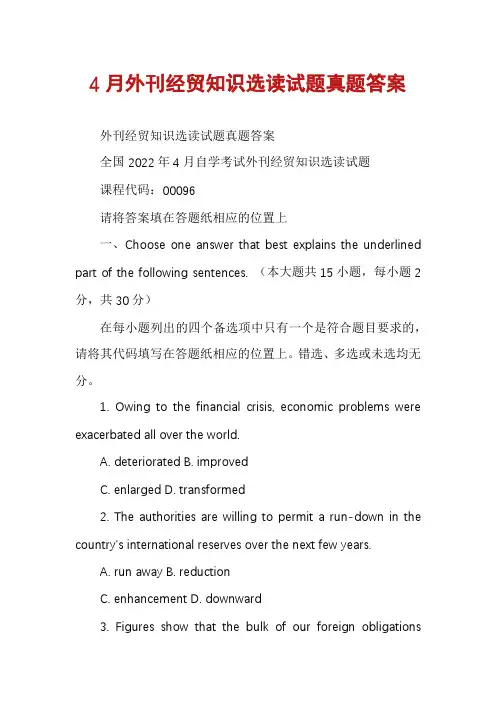
4月外刊经贸知识选读试题真题答案外刊经贸知识选读试题真题答案全国2022年4月自学考试外刊经贸知识选读试题课程代码:00096请将答案填在答题纸相应的位置上一、Choose one answer that best explains the underlined part of the following sentences. (本大题共15小题,每小题2分,共30分)在每小题列出的四个备选项中只有一个是符合题目要求的,请将其代码填写在答题纸相应的位置上。
错选、多选或未选均无分。
1. Owing to the financial crisis, economic problems were exacerbated all over the world.A. deterioratedB. improvedC. enlargedD. transformed2. The authorities are willing to permit a run-down in the country’s international reserves over the next few years.A. run awayB. reductionC. enhancementD. downward3. Figures show that the bulk of our foreign obligationsconsist of non-bank trade-related credits.A. investmentsB. profitsC. revenuesD. debts4. Foreign investors want to enjoy the same tax status as the domestic ones.A. treatmentB. declineC. supportD. objection5. More than a decade of fast growth makes China to supplant Japan as West’s main trade worry in Asia.A. exceedB. replaceC. agreeD. defeat6. Many governments have promised to take measures to help the unemployed.A. actionB. sizeC. degreeD. care7. Discrimination against goods from foreign countries is prohibited by WTO.A. equalityB. fairnessC. different treatmentD. strict policy8. America’s embrace of the free-trade agreements balanced all the criticism from the developing countries.A. suggestionB. insistenceC. oppositionD. acceptance9. Because of the mutual benefits no one would take a breach of those law lightly.A. offenceB. obedienceC. strikeD. rest10. Economists reckon Japanese bilateral trade surplus with America is also growing rapidly.A. recognizeB. calculateC. predictD. suggest11. Korea’s ambitious plans include a wholesale revamping of the country’s basic ind ustries.A. reconstructingB. retractingC. releasingD. reverting12. Even the well established consultants are finding it hard to secure definitive lucrative projects.A. profitableB. reasonableC. safeD. risky13. Japanese managers act more like western managers, putting profits before their firm’s market share.A. opportunityB. prospectC. protectionD. part14. In the U.S. soft drink industry is dominated by Coca-Cola and PepsiCo.A. competedB. balanced外刊经贸知识选读试题真题答案C. madeD. controlled15. Investment funds have moved out of commodities and into liquid assets.A. in the form of waterB. movingC. easily changed into cashD. clear二、Put the following phrases into English.(本大题共10小题,每小题1分,共10分)请将答案填写在答题纸相应的位置上。
外刊经贸知识选读(贸易术语翻译)1中国的对外贸易Nationai income 国民收入EEC(European Economic Association) 欧共体Most-favored nation treatment 最惠国待遇Visible trade account 有形贸易收支Minister without portfolio 不管部长Balance of payments 国际收支Invisible account 无形的贸易收支Current account 经常项目Center bank 中央银行Counter-trade 反向贸易Joint venture 合资企业OCCE(organization for economic co-operation and development) 经济合作发展组织Bank for settlements international 国际清算银行Non-bank trade related credits 买方信贷,卖方信贷等Manufactured goods工业产品Capital equipment 资本设备Industrialization programme 工业项目Heavy industry 重工业Economic imbalances 经济失衡Trade relating 贸易往来Per annum 每年Normalization of diplomatic relations 外交关系正常化Industrial country 工业国家In surplus 顺差Earnings and requirements 收入和需求Trade fairs 商品展销会Compensation trade 补偿贸易Raw materials 原材料Direct investment 直接投资The international capital markets 国际资本市场Commercial terms 商业条件Representative offices 办事处2中国的对外直接投资The China international trust investment copprporation (CITIC)中国国际信托投资公司The special economic zone 经济特区The state council 国务院Standard of living 生活水平Foreign-exchange reserves 外汇储备Capital stock 实际资本,股本Cooperative enterprise 合作企业Wholly foreign-owned operation 外商独资企业Consumer goods 消费品Capital goods 资本货物Customs duties 进口税Technical transformation技术改造Provincial capital 省会inner regions 内地,内陆readily obtainable 轻易得到economic and technicai development zone(ETDZ) 经济技术开发区uniform tax rate 统一税率profit-remittance利汇款率preferential tax rate 统一税率municipal govermment 市政府grassroots units 基层单位rules and regulations 规章制度comprehensive framework 综合准则public ownership of the means of production 生产资料公有制national people’s congress 全国人民到表大会seventh five-year plan 第七个五年计划china international economic consultants inc 中国国际经济顾问有限公司3中国开放的经济Commercial hud商业活动中心The world’ sdominant economy 世界经济强国Per capita 人均Gross national product (GNP) 国民生产总值American administration 美国政府China hands 中国通(华人)Punitive import tariffs 惩罚进口性关税Securities and real estate markets 证劵及房地产市场“G reater china” trade bloc “大中华”集团Gross domestic product(GDP) 国内生产总值Private businesses 私有企业Competitive advantage 竞争优势High wage economy 高工资经济General agreement on tariffs and trade(GA TT) 关税及贸易总协定Consumer eiectronics 电子产品Human rights 人权问题Preferred status 优惠地位,优先权State-owned conglomerate 国有跨行业公司Semiconductor chips 半导体集成电路芯片Brokerage services 经济业务Double digits 两位数4世界经济Per capita gross domestic product 人均国内生产总值Weak performance 不景气High rates of growth 高增长率The gulf crisis 海湾危机International conditions 国际坏境The group of seven 七国集团Continental Europe 欧洲大陆Disinflationary policies 反通胀政策Weakness in demand 需求疲软Cyclical deceleration in investment spending 周期性的投资下降Short-term dollar interest rates 短期美元汇率Nonoil commodity prices 非石油商品价格Foreign exchange 外汇Hard currencies 硬货币Severely indebted 负债严重The Uruguay round of GATT 关贸总协定乌拉圭回合Commodity market 商品市场Nominal(dalloar)terms 名义(美元)价Constant(dollar)terms 不变(美元)价Real terms 实际价The united nations conference on environmentand development 联合国坏境和发展会议Anti-inflationary monetary policy 反通货膨胀政策GDP(GNP)deflator 消除国内(民)生产总值通货膨胀指数The cyclical slowing of investment 周期性投资放缓Tax-cut-induced boom 由减税引发的繁荣Interest rates 利率Unemployment rates 失业率Financial stress金融压力Tightening of credit 紧缩信贷Current account deficit 经常项目赤字Yield curve收益曲线European monetary system(EMS) 欧洲货币体系Accommodative monetary policy 肯通融的货币政策Nominal short-term interest rates 名义短期汇率Real output 以不变价格计算的产品价值Structural transformation 结构转变,体制改革Trading partners 贸易伙伴The population-weightted growth rate 人均加权增长率Debt restructuring债务调整Portfolio investment 证劵投资Per capita income 人均收入Fiscal adjustment 财政调整Investment liberalization 投资自由化Trade-oriented region 贸易导向型地区Market-oriented regional integration 市场导向型区自由化Multilateral trade agreements 多边贸易协议Budget deficit预算赤字Emergency stabilization measures 紧急稳定措施Tight credit policies信贷紧缩政策Exchange-rate devaluation 汇率贬值The council mutual economic assistance( C MEA) 经互会5关于美国的贸易策略与政策Trade representative贸易代表Trade policies 贸易政策Trade sanctions 贸易制裁Trade barrier 贸易壁垒Trade surplus 贸易赤字North American free-trade agreement 北美自由贸易协定Trade priority 贸易优先权Government procurement 政府采购Free-trade agreement 自由贸易区Ttrade signals 贸易信号6欧盟的发展European community欧洲共同体The single market统一大市场The European community vast single market 欧共体的统一大市场Barrier-free market 无壁垒市场European integrationg 欧洲一体化The internal market 内部市场Marriage contract 结婚契约Political and economic integration 政治经济一体化Free-trade zone 自由贸易区Free market philosophy 自由市场论Economic benefits 经济利益Economic activity经济活动Annual growth rate 年增长率Plant modennization工厂现代化Budget cuts 预算消减7关于日本的贸易地位Import targets 进口指标Guantifiable results 定量结果,量化结果White paper 白皮书Uruguay round of trade talks乌拉圭回合谈判Average tariff 平均关税Manufactured goods制成品Bilateral surplus 双边顺差Fiscal packages 财政一揽子计划Trade in goods 易货贸易International bodies 国际组织Industrial commodities 工业商品Business cycle商业周期Economic cycle经济周期Managed trade 管理贸易Consumer goods消费品Market share市场份额Households save家庭储蓄Budget deficit预算赤字Trade balance贸易差额Public opinion工众舆论Trade reprisals贸易报复8亚洲国家发展问题Corporate headguaters公司总部Silicion valley硅谷Annual sales年销售额Nation economic machine国家经济结构Industrial infrastructure工业基础设施Investment capital投资资本Antidurmping suits反倾销起诉Fledging conglomerates新兴的跨行业工资Literacy rate脱盲率,识字率Middle class中产阶级Nouveau riche暴发户Government-backed loans 政府担保贷款Human-rights restrictions 人权限制Political liberalization政治自由化Political opposition政治反对派Driving force驱动力Labor-cost advantage劳动力成本优势Industrial group工业集团Basic industries基础工业Industrial structure工业结构Industrial giants大工业企业Business setback商业挫折Tax breaks税额优惠Direct subsidies直接补贴Market forces 市场力量Financial system金融体制Official interest rates官方汇率Consumer market消费市场9贸易新星Gulf region海湾地区Sovereignty dispute主权争端GCC(gulf cooperation council)海湾合作委员会OPEC (organization of petroleum exporting)石油输出国组织Carbon tax双重税收Firm order实盘Non-oil trade非石油贸易Manufacturing capacity生产能力Government grants政府津贴Risk-weighted assets风险加权资产Import surcharge进口附加税Certificates of origin原产地证书The developing areas开发区Lucrative fees利率报酬10从关税贸易总协定到世界贸易组织Economic growth促进经济发展Common agricultural policy (CAP)共同农业政策Liberal market自由贸易Market force市场力量Monopoly purchasing boards统购部门Export subsidies生产补贴The administration’goals政府目标Technical standards技术水平Anti-dumping measures反倾销措施Countervailing duty反倾销税,抵消性关税Intellectual property right知识产权Trade in services服务贸易Farm-trade liberalization农业贸易自由化Majority vote多数选票Straight forward of vote直接否定权11易货贸易仍在使用I nternational financial institution国际金融机构Currency reserves货币储备Of equivalent value同等价值Mean of trade贸易方式Client states附属国International monetary found(IMF)国际货币基金组织Multilateral trade多边贸易Convertible currency可兑换货币Burden of debt债务负担Debt service=intrerst payment利息付款Debtor nation债务国Export earning出口收入Multinational corporations跨国公司Compensation agreements补偿贸易协定Clearing agreements清算系统Bilateral pacts双边协议Credit-starved信用危机Letter of credit信用证12市场竞争Test market试销市场Baby-boomers生育高峰期出生的人Consumer coupons消费优惠劵Price promotions价格促销Exclusive contract独家经销合同Competitive in price andguanlity价格和质量上的竞争力All-out sales campaigns大规模销售战役Hard sell硬销售Heavy discounting大幅度打折Soft drink软饮料Retail sales零售Special promotion特殊销售13市场分析Export market出口市场Fast food shop快餐The method of packing包装方式Subsidized competition补贴性竞争Grocery store杂货店Wet market鲜货市场The retial market零售市场Promote sales促销商品Export enhancement programe增加出口计划Structure of trade贸易结构Preserved duck eggs咸鸭蛋14初级商品市场Soft commodities非耐用初级产品Agricultural commodoties农产品Surplus produce剩余产品Financial futures以期货形式交易的有价证劵The money market货币市场The equity market一般的股票市场Basic raw materials基本原材料Conference on trade and development联合国贸易和发展协会Currency movements货币变动Special drawing right特别提取款Food price index食品价格指数Glut of supplies供应过剩Devastating consequences毁灭性后果Spin-offs副作用Cash-strapped现金短缺at its weakest萧条services sector服务部门official austerity programmers政府紧缩计划foreign exchange earnings外汇收入unit commodity price单位初级产品价格real interest rates实际利率stores of vaule储备价值liquid assets流动资产price volatility价格多变speculative business投机生意the patten of supply and demand供需模式export quote出口配额in short supply 供应短缺15初级商品市场行情电传报告Commodities dealers初级商品交易商Stock exchange证劵交易所Investment support投资支持Regained ground重得青睐Labour dispute劳务纠纷Export figures出口量Good resistance强烈抵制Discount rate贴现率Labour-agreement劳动协议Bleak outlook前景黯淡Futures markets期货市场Spot market现货市场Strategic stockpile战略性库存Take prices back使价格回升Terminal prices期货价格International coffe organizayion(ICO)国际咖啡组织Upward adjustment 上调Replacement costs重置成本。
Lesson 1China in the Market PlaceBarry Coulthurst examines the development of China’s trade policy and the present state of the overseas economic links --巴里库尔塞斯特对中国贸易政策的演变和当前与海外经济往来状况的研究The pattern of China’s foreign trade has changed substantially since the founding of the people’s Republic, During the 1950s China exported agricultural products to the USSR and East European countries in return for manufactured goods and the capital equipment required for the country’s industrialization programme which placed emphasis on the development of heavy industry. The Great Leap Forward of 1958-1959 initially produced gains in agricultural and industrial production, but subsequently resulted in serious economic imbalances. Economic problems were exacerbated by three bad harvests (1959-1961) with the result that national income and the volume of foreign trade contracted during 1960-1962 The withdrawal of Soviet economic and technical aid in the early-1960s caused trade to shift away from the USSR and its Comecon partner towards Japan and Western Europe. A consistent theme of China’s foreign trade policies has been the strong emphasis which has been placed on developing trade relations with the Third World countries.The growth of foreign trade was disrupted again during the cultural Revolution(1966-1976) when agricultural and industrial production fell sharply and transportation constraints became more serious.Foreign Trade, which has a major role in the four Modernizations programme, has grown rapidly over the past few years.A major trade agreement with Japan, under which China exports coal and oil in return for industrial equipment and technology was signed in February 1978. China also signed a long-term trade agreement with the EEC in 1978 while trade with the USA has increased rapidly in the wake of the normalization of diplomatic relations at the beginning of 1979. The Sino-USA agreement on trade relations, which came into force in February 1980. Accords China Most-favoured nation treatment.BreakdownA commodity breakdown of China’s trade shows that fuels accounted for 24 per cent of total exports in 1982, food products for 13 percent, textile fibres and mineral ores for 7 per cent and manufactured goods(the most important products were textiles, chemicals and machinery and transport equipment ) for 55 percent. Since the founding of the people’s republic strong emphasis has been placed on importing capital equipment in order to strengthen the industrial sector. But the leading categories of imports in 1982 were food, which accounted for 22 percent of total, light manufactured items with a share of 20 percent and machinery and transport equipment with 17 percent.During the past few years a major objective of the Chinese authorities has been to reduce the proportion of agricultural exports, while increasing that of industrial and mineral products. A wide variety of industrial goods are now exported and Chinese capital equipment has been used by a number of developing countries to establish projects in areas such as agriculture, forestry, light industry, food processing, water conservation and transport and communications.The Balance Shifts.The US dollar value of Chinese exports increased at an average rate of almost 18 percent per annum between 1978 and 1983, while imports increased by approximately 11 per cent pere annum. As a result, the visible trade surplus rose sharply from US$1.4 billion in 1981 to US$4.4 billion in 1982 AND us$3.7 billion in1983. Exports grew much faster than imports during this period not only because of the strong emphasis placed on exporting by China’s economic planners, but also because a number of industrial projects were postponed in 1979. Official recognition that foreign technology could play a major role in modernizing the Chinese economy had caused imports to rise by more than 50 percent in 1978 placing undue strain on the national economy. Grain imports have fallen sharply over the past few years- China became a net grain exporter in 1984 – and in 1983 the country started to export soyabeans and cotton.The pattern of foreign trade growth was reversed in 1984; the value of exports increased by 10 percent, but imports jumped 38 percent with the result that the visible trade account was in deficit by US$1.1 billion. The strong increase in importslast year is attributed to buoyant economic activity as well as to the success of the Government’s trade and foreign investme nt policies.Direction of TradeHongKong is China’s major export market accounting for approximately 26 percent of total exports in 1983(though much is re-exported to other destinations from there). Other important markets include Japan, with a share of 20 percent in 1983, and the USA with approximately 8 percent. The EEC’s share of China’s exports has generally been around 11-12 percent over the past few years (the leading export markets within the European Community are Germany and United Kingdom), while the proportion destined for the comecon countries declined from almost 15 percent in 1978 to 6 percent in 1983. The non-oil developing countries (excluding Hong Kong) accounted for 23 percent of China’s total exports in 1983.In sharp contrast the developing countries provided less than 15 percent of China’s imports in 1983. The most important suppliers among the industrial countries were Japan, with a share of 26 per cent, and the USA with 13 percent. The EEC’s share in 1983 was 15 percent and that of comecon 8.2 per cent.The successful outcome to negotiations between Britain and China about the future of Hong Kong will strengthen Sino-British relations and is expected to boost trade between the two countries. A large British economic and trade delegation, headed by Lord Young, Minister without portfolio, visited China in March. The value of Chinese exports to Britain, which rose rapidly between 1977 and 1980, declined in 1981-1982, but recovered strongly in 1983; imports from the United Kingdom followed a similar pattern. The most important Chinese exports to Britain in 1983 were clothing, textile fibres, tea and food products while the leading British exports included iron and steel, machinery and transport equipment, scientific instruments, chemicals and textile fibres.Chinese officials stress the importance of introducing advanced technology to domestic industry, but the need is for technology of varying degrees of sophistication, not necessarily for advanced technology as that term is understood in the West.Reserves RiseThere are no official statistics covering the invisible account of the balance of payments, but the size of the visible trade surplus during 1981-1983 and a pronounced increase in earnings from tourism suggest that the current account has been in surplus over the past few years.Foreign exchange reserves have risen rapidly from approximately US $2.5 billion at end-1980 to US$17.0 billion (sufficient for approximately eight months’ imports) by October 1984. Approximately US $12 billion of the country’s r eserves are held by the central bank, the people’s bank of China, while the balance is controlled by the bank of China which specializes in foreign exchange business. Individual cities must try to balance their foreign exchange earnings and requirements, but there is some scope for purchasing additional foreign exchange with Renminbi yuan. The authorities are willing to permit a run-down is the country’s international reserves over the next few years as a means of accelerating the introduction of foreign technology.China has shown a much more flexible approach to foreign trade over the past few years and has adopted a series of measures designed to strengthen international economic co-operation. Foreign countries are encouraged to mount exhibitions of their goods and China itself has participated in a number of trade fairs and exhibitions held abroad. Since the late 1970s China has also adopted foreign trade practices long-established in many other countries. Goods are produced according to a sample provided by customer, while strong encouragement is given to compensation trade whereby a foreign seller supplies raw materials and equipment and receives manufactured goods, produced by the equipment provided, in return. Compensation trade differs from barter or counter-trade insofar as there is a direct link between the equipment supplied from abroad and manufactured product. Assembly manufacturing began in 1978 and particular forms of foreign trade are eligible for exemption from customs duties and taxation.Investment EncouragedA series of polices designed to encourage foreign investment have accompanied these trade reforms. A lao adopted in1979 defines the principles governing the rights and interests of participants in joint ventures. The China International Trust and Investment Corporation(CITIC), established in 1979, co-ordinates incoming foreign investment, promotes joint ventures by assisting Chinese and foreign enterprises to find suitable business partners and also has responsibility for negotiating contracts relating to 100 percent foreign-owned enterprises When negotiations are complete and a joint venture contract has been agreed, it is submitted to the ministry of foreign Economic Relations and Trade for final approval.China’s cautious approach to f oreign borrowing is to be maintained, at least for the time being. The debt problems confronting a number of developing countries have reinforced China’s determination to introduce foreign technology by means of direct investment and concessionary finance rather than by raising substantial sums of money on the international capital markets. Foreign investments is advantageous insofar as it facilitates the transfer of technology and skills and avoids creating an overhang of debt. The authorities do not consider it appropriate to incur large amounts of external debt until a number of practical bottlenecks in the economy, such as an inadequate transport network and energy constraints, have been tackled. China’s access to substantial sums of money from the World bank also reduces the need to borrow on commercial terms.China has borrowed almost US$2 billion from the world bank and its affiliates, but a substantial proportion of these loans are still to be disbursed. Figures compiled by the OECD and the bank for international settlements show borrowings from western commercial banks of approximately US$2 billion, but also show that the bulk of China’s foreign obligations consist of non-bank trade related credits which exceed US $4 billion.While there are limited lending opportunities in the short-term, there appears considerable scope for foreign banks to undertake profitable business over the longer term. The need to develop business relationships with Chinese enterprises and government officials have persuaded a large number of foreign banks to open representative offices in Beijing or other parts of China.From China now spring 1985 no. 112。
外刊经贸知识选读翻译(1)精品⽂档Lesson 12Soft Drink Wars: the Next Battle The reformulation of Coke has given the feuding cola giants a chanee to go at each other again. 可⼝可乐的重新配⽅为长期不和的可乐巨头提供了⼀个新开战的机会。
But Coca-Cola and PepsiCo are spoil ing for yet ano ther fight, and this time they'e pick ing on the little guys: non-cola makers like Seven-Up and Dr Pepper.By Monci Jo Williams 但是可⼝可乐和百事可乐⼀⼼想进⾏另⼀场战⽃,这⼀次它们选中了⼩企业:“七喜”和“佩拍博⼠” 。
In the U.S. soft drink industry, where 1% of the market is worth $ 300 million in retail sales, Coca-Cola and PepsiCo don 'wage mere market share battles. They fight holy wars. These days the fight ing is on two fron ts. One is on the vast pla ins of the cola bus in ess, where the reformulatio nof Coke has Pepsi on the defensive. The other is in the back alleys of the smaller,non-cola market. Un til now these have bee n domin ated by other compa ni es. As growth of high-calorie colas slows, however, Coca-Cola and PepsiCo are in vadi ng new territory.在美国的软饮料⾏业,1 %的市场份额就意味着3亿美元的零售额,可⼝可乐公司和百事可乐公司进⾏的不仅仅是争夺市场份额的⽃争,他们进⾏的是“圣战”。
一、单项选择题:本大题共15小题,每小题2分,共30分。
在每小题列出的四个备选项中只有一个可以替代句中划线的单词或词组,请将其选出并将答题卡(纸)的相应代码涂黑。
错涂、多涂或未涂均无分。
1. Whenever there is shortage of any specific goods,we'll replace by other goods with equivalent value.A. sameB. extraC. highD. low2. The slump in consumer confidence has created panic in the stock market.A. slow-downB. go-aheadC. drop-offD. speed-up3. The progress in European integration provides a solid underpinning for Europe's future development.A. theoryB. criticC. explanationD. basis4. Our country will achieve a state of law and order that we all aspire to.A. learn fromB. long forC. start upD. cope with5. If those systems are of high quality,your business will have an edge on the competitors.A. advantageB. pressureC. threatD. border6. Our economic relationship with China adds $2,400 per annum to every household through exports and investment.A. forevery shareB. for every yearC. for everyoneD. for every country7. We drew lessons from other countries about risk management in the wake of the financial crisis last year.A. betweenB. afterC. beforeD. during8. The American goverment avoided a direct confrontation with China on the currency issue.A. negotiationB. contactC. compromiseD. fight9. During the process of globalization,the enterprises should take measures to reduce the pollical risks.A. accountB. sizesC. actionsD. care10. The U.S. Chamber of Commerce is supporting the efforts of some U.S. lawmakers to end the trade embargo on Cuba.A. relationB. freedomC. prohibitionD. dispute11. Some politicians accuse the U.S. of deliberately wrecking such agreement.A. supportingB. destroyingC. opposingD. pushing12. Officials in China are urging eligible couples to have two children because of concerns over an ageing population.A. qualifiedB. urbanC. powerfulD. wealthy13. China's average tariff level has dropped to 5% now as the country fulfills its commitments to the WTO.A. outputB. employmentC. salaryD. tax14. For the past ten years,Japan has been virtually at a standstill while a number of countries promoted bilateral economic partnerships.A. prosperityB. stagnationC. deteriorationD. stability15. We believe the reduction should be easily offset by the unexpected increase in investment growth.A. increasedB. cutC. maintainedD. compensated二、判断题:本大题共10小题,每小题2分,共20分。